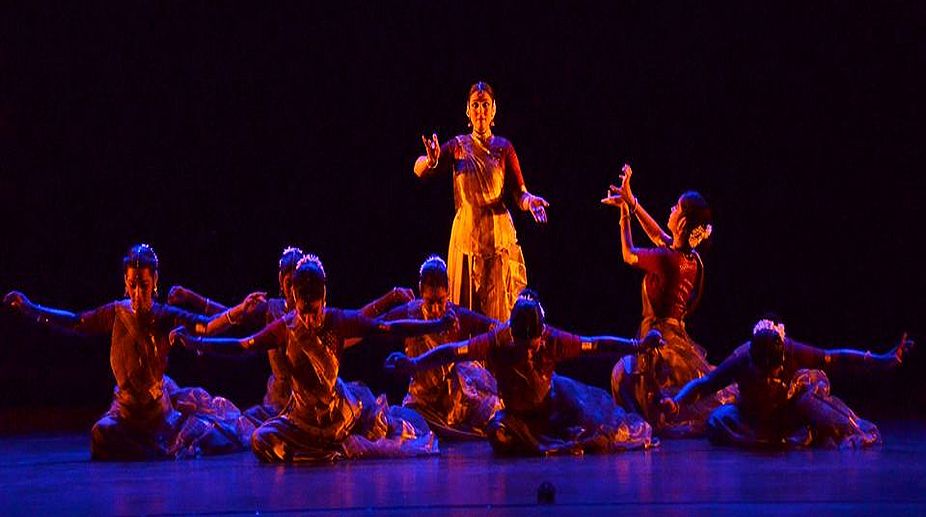World Dance Day festival at India International Centre
The events will take place at the India International Centre on Saturday, 27 April and Sunday, 28 April.

Mahagami Gurukul Aurangabad (PHOTO: FACEBOOK)
The World Dance Day (WDD), which falls on 29 April, is celebrated world over with great enthusiasm. This year the celebrations started a week earlier when the Mahagami Gurukul Aurangabad organised a two-day festival on this occasion, conceived and curated by Guru Parwati Dutta.
The inaugural evening featured Parvati Dutta in a solo performance Varnaja. The unique and original idea of the talented dancer choreographer Parwati, juxtaposed calligraphy and Kathak, creating calligraphic images that came alive through Kathak. The Varna, or alphabets of the calligraphy, were organised in the conventional repertoire of Kathak, opening with“Akshar Dhyan”, an invocation to the primordial sound “Naad”,from which the universe is said to have originated. This exploration of Aakar,or form, was based on the Maheshwar Sutra produced by Shiva Damru, comprising the 14 Varnas, when Shiva performed the cosmic dance.
Shabda-Roop,the written form, underlined the metaphysical (Adhyatmic),aesthetic (Saundarya),structural (Rachana), spatial (Akasha), temporal (Kaal) and technical (Upayojana) of the Varna for creativity in dance, music and the calligraphy. Parvati explored the possibilities of patterns in space and time through movements in this abstract piece, equating the Naad-Shabda-Laya of dance with the Bindu-Rekha-Aakar and Kalpana (imagination) in calligraphy. “Om-Allah” next underlined Kathak as a secular art form. “Aakar” had the delicate “Gat-Nikas”, creating the imagery of the calligraphic panels Parwati moved through. The concluding “Shabda-Dhyan” completed the journey to spiritual destination of both the dance and the calligraphy. The thoughtfully composed music, the competent live orchestra and light design for each and every item enhanced the beauty of Varnaja, an admirable expression of sound, idea and inspiration through form.
Advertisement
Pravaahi, next evening, comprised three group choreographies in Kathak, namely Ajara,Vaari and Vegini, evoking the flow of the river in Ajara, the immortal Saraswati and Vegini. Vaari, which also means water, underlined the “pilgrimage beyond self” through the devotional wave or the BhaktiPravaah of the Vaarikari Sampraday, inspired by the devotional poetry of Sant Jnaneshwar. The multi-hued dance sequences, based on myriad musical treasures, from Abhanga to the folk music of Maharashtra, took the audience through the multilayered and multidimensional interpretation of the poetry. The authentic music and costumes enlivened the imaginative choreography. Both Varnaja and Pravaahi deserve to be seen by the dance lovers and connoisseurs outside Aurangabad as well.
* * *
Guru Geeta Chandran, the founder president of Natya Vriksha, organised the WDD-2017 in association with the India International Centre (IIC) on 29-30 April. Shanta Sarbjeet Singh was bestowed the first Natya Vriksha Lifetime Achievement Award for her valuable contribution to dance. Kapila Vatsyayan launched Dance in Retrospect-Part II,the special issue of the SNA journal edited by Sunil Kothari, compiling the papers presented in the historic 1958 dance seminar. Kothari spoke about his life journey in dance and how this seminar changed the course of his life from being a Chartered Accountant to becoming a dance historian, author and a dance critic. The interesting images he showed along with his talk took the audience along the interesting journey. The second illustrated lecture next day was delivered by Sheela Nambiyar on Health for Dance.
The Young Dancers Festival opened with a brilliant Bharatanatyam performance by Aniruddha Knight, the gifted grandson of the legendary Balasaraswati, who runs the Balasaraswati Institute of Dance in Chennai. Opening with the customary Alarippu, he went to the Varnam “Mohamanam…” in Bhairavi for Brihadeeshwara that had an old world charm in the Abhishekam and Shringar of the deity, or in offering the Tamboolam…like a romantic gesture. The Kshetrayya Padam in Gaulipantu raga next, sounded quite similar to Hindustani Shree. Aniruddha brought his recital to its climax with his touching Abhinaya for “Krishna ni begane baro…”, immortalised by Bala herself. He was accompanied by a live orchestra with his father Douglas Knight on Mridangam, Usha Shivakumar (Vocal), K V Rakesh (Nattuvangam) and T R Murti on Flute.
Gauri Divakar’s scintillating Kathak was the other attraction of the inaugural evening of Young Dancers Festival. She opened with an invocation to Lord Ganesha and His parents Shiva-Parvati. Mugdha, a celebration of beauty and womanhood, had the music composed by Shubha Mudgal and Aneesh Pradhan. She concluded with Resonance, based on the Sufi poetry of Maulana Hasrat Mohani. This would have made the ideal culmination had she resisted from concluding with “Hari Ho Gati Meri”,which made her performance unnecessarily repetitive.
The next evening of the Young Dancers Festival showcased Nandita Devi in Manipuri and Purva Dhanashree in Vilasini Natyam. Both of them excelled in their specific dance styles. There were dance workshops in the morning titled, Everyone Can Dance, with age no bar. Bharatanatyam one, conducted by Guru Geeta Chandran herself, and the Chhau workshop under Guru Shashadhar Acharya, saw a large number of participants enjoying themselves, making the most of this opportunity.
Advertisement